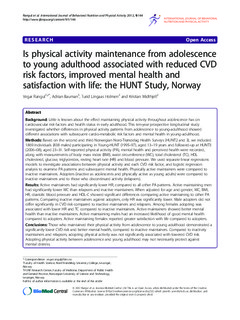| dc.contributor.author | Rangul, Vegar | |
| dc.contributor.author | Bauman, Adrian | |
| dc.contributor.author | Holmen, Turid Lingaas | |
| dc.contributor.author | Midthjell, Kristian | |
| dc.date.accessioned | 2019-10-17T13:28:35Z | |
| dc.date.available | 2019-10-17T13:28:35Z | |
| dc.date.created | 2013-01-04T09:56:14Z | |
| dc.date.issued | 2012 | |
| dc.identifier.citation | International Journal of Behavioral Nutrition and Physical Activity. 2012, 9 (144), . | nb_NO |
| dc.identifier.issn | 1479-5868 | |
| dc.identifier.uri | http://hdl.handle.net/11250/2622824 | |
| dc.description.abstract | Background
Little is known about the effect maintaining physical activity throughout adolescence has on cardiovascular risk factors and health status in early adulthood. This ten-year prospective longitudinal study investigated whether differences in physical activity patterns from adolescence to young-adulthood showed different associations with subsequent cardio-metabolic risk factors and mental health in young-adulthood.
Methods
Based on the second and third Norwegian Nord-Trøndelag Health Surveys (HUNT2 and 3), we included 1869 individuals (838 males) participating in Young-HUNT (1995–97), aged 13–19 years and followed-up at HUNT3 (2006–08), aged 23–31. Self-reported physical activity (PA), mental health and perceived health were recorded, along with measurements of body mass index (BMI), waist circumference (WC), total cholesterol (TC), HDL cholesterol, glucose, triglycerides, resting heart rate (HR) and blood pressure. We used separate linear regressions models to investigate associations between physical activity and each CVD risk factor, and logistic regression analysis to examine PA patterns and subsequent mental health. Physically active maintainers were compared to inactive maintainers. Adopters (inactive as adolescents and physically active as young adults) were compared to inactive maintainers and to those who discontinued activity (relapsers).
Results
Active maintainers had significantly lower HR, compared to all other PA patterns. Active maintaining men had significantly lower WC than relapsers and inactive maintainers. When adjusted for age and gender, WC, BMI, HR, diastolic blood pressure and HDL-C showed significant differences comparing active maintaining to other PA patterns. Comparing inactive maintainers against adopters, only HR was significantly lower. Male adopters did not differ significantly in CVD risk compared to inactive maintainers and relapsers. Among females adopting was associated with lower HR and TC compared to inactive maintainers. Active maintainers showed better mental health than inactive maintainers. Active maintaining males had an increased likelihood of good mental health compared to adopters. Active maintaining females reported greater satisfaction with life compared to adopters.
Conclusions
Those who maintained their physical activity from adolescence to young adulthood demonstrated a significantly lower CVD risk and better mental health, compared to inactive maintainers. Compared to inactivity maintainers and relapsers, adopting physical activity was not significantly associated with lowered CVD risk. Adopting physical activity between adolescence and young adulthood may not necessarily protect against mental distress. | nb_NO |
| dc.language.iso | eng | nb_NO |
| dc.publisher | BMC (part of Springer Nature) | nb_NO |
| dc.rights | Navngivelse 4.0 Internasjonal | * |
| dc.rights | Navngivelse 4.0 Internasjonal | * |
| dc.rights.uri | http://creativecommons.org/licenses/by/4.0/deed.no | * |
| dc.rights.uri | http://creativecommons.org/licenses/by/4.0/deed.no | * |
| dc.title | Is physical activity maintenance from adolescence to young adulthood associated with reduced CVD risk factors, improved mental health and satisfaction with life: the HUNT Study, Norway | nb_NO |
| dc.type | Journal article | nb_NO |
| dc.type | Peer reviewed | nb_NO |
| dc.description.version | publishedVersion | nb_NO |
| dc.source.pagenumber | 11 | nb_NO |
| dc.source.volume | 9 | nb_NO |
| dc.source.journal | International Journal of Behavioral Nutrition and Physical Activity | nb_NO |
| dc.source.issue | 144 | nb_NO |
| dc.identifier.doi | 10.1186/1479-5868-9-144 | |
| dc.identifier.cristin | 980653 | |
| dc.description.localcode | © 2012 Rangul et al.; licensee BioMed Central Ltd. This is an Open Access article distributed under the terms of the Creative Commons Attribution License (http://creativecommons.org/licenses/by/2.0), which permits unrestricted use, distribution, and reproduction in any medium, provided the original work is properly cited. | nb_NO |
| cristin.unitcode | 194,65,20,0 | |
| cristin.unitname | Institutt for samfunnsmedisin og sykepleie | |
| cristin.ispublished | true | |
| cristin.fulltext | original | |
| cristin.qualitycode | 2 | |

